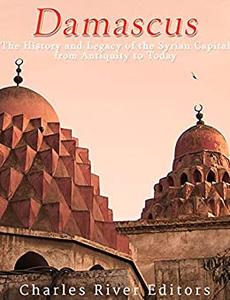
Free Download Damascus: The History and Legacy of the Syrian Capital from Antiquity to Today by Charles River Editors
English | February 6, 2017 | ISBN: 154294385X | 65 pages | EPUB | 2.23 Mb
*Includes pictures
*Includes ancient accounts of Damascus' history
*Includes online resources and a bibliography for further reading
"Nicolaus of Damascus, in the fourth book of his History, says thus: 'Abraham reigned at Damascus, being a foreigner, who came with an army out of the land above Babylon, called the land of the Chaldeans: but, after a long time, he got him up, and removed from that country also, with his people, and went into the land then called the land of Canaan, but now the land of Judea, and this when his posterity were become a multitude; as to which posterity of his, we relate their history in another work. Now the name of Abraham is even still famous in the country of Damascus; and there is shown a village named from him, The Habitation of Abraham.'" - Josephus
"In Damascus there is a mosque that has no equal in the world, not one with such fine proportion, nor one so solidly constructed, nor one vaulted so securely, nor one more marvellously laid out, nor one so admirably decorated in gold mosaics and diverse designs, with enamelled tiles and polished marbles." - Muhammad al-Idrisi, 1154
Throughout history, Syria has been dominated not by one great city but by two. Aside from Aleppo to the north, the religious and commercial metropolis of Damascus has been a place desired by the powerful. For thousands of years the Phoenicians, Hittites, Assyrians, Babylonians, Greeks, Romans, Christians, and Muslims all vied for control of the city.
Damascus has many important architectural sites dating from almost all eras of its history, and vestiges of the past have existed and been valued in Damascus throughout its existence. The history of Damascus from the Byzantine period to the 12th century is particularly fascinating, in terms of its role as the capital of the Umayyad Caliphate and the changes that it experienced when the Abbasid Caliphate and Seljuk dynasty came to power.
At Damascus, the vibrant capital of modern Syria, one can experience the passion and spirituality of the many faiths that have coexisted in Syria for centuries. The stories of Damascus are a living embodiment of the age of Islamic renaissance; the city has one of the oldest and most important mosques in the world, and it has a vibrant history linked to the rise of Islam in the region.
The Umayyad Mosque is a wonderful illustration of the continuity of sacred sites in the city through the millennia. Although it has never been subjected to an archaeological investigation, this was probably the site of a temple of the Semitic thunder god Haddad, and it was certainly the site of the Roman cult of Jupiter following the amalgamation of Haddad with the Roman god, typical of the syncretic approach that the Romans took to foreign religions. It was also certainly the site of the Christian Cathedral of St. John the Baptist; in fact, it may be surprising to learn that the relics of St. John the Baptist are held within this mosque, and are revered by Muslims and Christians alike. Christians make up about 10 percent of the population, with the remainder being mostly Muslim. A number of Christian holy sites relating to the conversion and work of St. Paul - who is considered by many to be the main founder of the Christian church after Jesus - can be found in Damascus. The longstanding tolerance and respect between people of different faiths in Syria is a noteworthy feature of this exceptional city.
Damascus: The History and Legacy of the Syrian Capital from Antiquity to Today examines the tumultuous history of one of the most important places in the Middle East. Along with pictures depicting important people, places, and events, you will learn about Damascus like never before.
